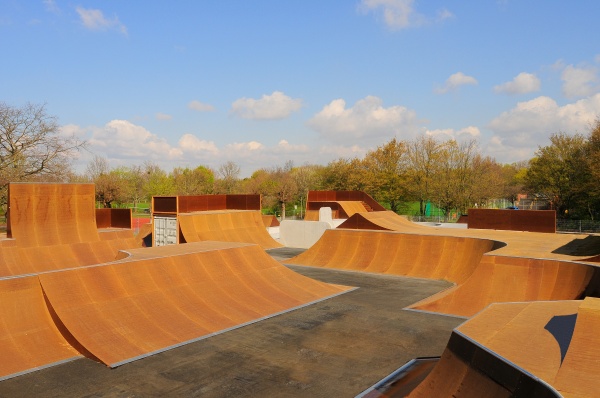Inspect First - Then Refurbish
In recent years, the number of artificial pitches used to practise sports has continued to increase, largely replacing old surfaces such as ...


YOUR FORUM FOR PLAY, SPORTS UND LEISURE AREAS

The facility of the "Die Stadtmauer" BMX club, which had been there since 1992, had to make way for a new school building. It was decided to build the new facility on an old sports field in the northern part of Darmstadt. In the middle of the park, which was created in the 1970s, there are various sports zones.
The design planning was done in very close coordination with a BMX club during several intensive participatory and coordination meetings.
The newly built BMX park in Bürgerpark-Nord is one of the largest and most modern outdoor BMX facilities in Germany and provides riders of all skill levels with wooden ramps and bowls on a total area of approximately 3,500 square metres.
Noise barrier
Based on the noise survey, a 40-metre-long and at least 5-metre-high noise barrier wall had to be erected in the southern area of the bike park. The noise barrier wall was made of Legioblocks, as they are termed.
The wall, measuring 40 x 5.2 metres, was integrated into the ramps and enables wall rides and transfers within the facility.
The Legioblock system is an innovative and flexible modular construction system made of stackable concrete blocks that can be installed like Lego concrete blocks without using cement or fasteners. The weighted sound reduction index Rw(C;Ctr) is 25(-1;-2) dB in accordance with the DIN EN ISO 717-1 standard. This value is based on the standard spectrum for outdoor noise (and traffic noise).
Trench drain infiltration
All rainwater is infiltrated on site by means of two infiltration trenches. The rainwater is cleaned by a pre-filter gutter with substrate. In the bowl area, the remaining precipitation water is also cleaned in two drain inlets through a sieve with a silt bucket.
Bike park
The bike park has two entrances with seating areas (including litter bins) and a pavilion, providing shelter in bad weather.
The facility has an approximately 650 m² concreted area and approximately 2000 m² asphalted area with wooden ramps built on top.
A special feature is the integrated resi ramp. A resi ramp is a ramp with foam and rubber padding that is ideal for riders to try jumps and other tricks.
The resulting overall facility has an area for beginners up to areas for advanced riders. The ramps have been specifically placed in all areas to allow for as many transfers (tricks) as possible. All ramp sizes and radii have been designed to ensure maximum riding comfort and to allow each rider to reach their maximum potential.
The bike park is divided into different areas that can also be used as a single large track. The ramp areas are divided into five sections:
Park: Made of wood and can be ridden in either direction. It consists of quarter pipes of different radii and heights, transitioned walls, wall rides, curved wall rides, step up, step up-step down, jump box, spine, spine box, hips at 45 and 90 degrees, banks and a variety of transfers.
Jump line: Made of wood and forms a line of jump box, spine, hips and quarter pipes.
Bowl: Concrete bowl inspired by the "Little Devil Bowl" from Pennsylvania, USA, and allows for a wide variety of transfers. The bowl was produced using shotcrete and includes two different wall rides and a spine. The hand-smoothed concrete surfaces allow for a wide range of uses and are low-maintenance in the long term.
Street: The obstacles are made of wood and are suitable for beginners as well as for practising on the "street".
Resi: Made of wood and consists of jump box, spine and quarter pipe, which are covered with a resi layer to ensure maximum safety when practising tricks.
The mat was developed in cooperation with an Austrian manufacturer of ski slope impact protection systems for precisely this purpose and tested in advance.
It is a non-water-absorbent PE foam in various thicknesses from 22 to 15 cm. The sheathing is a PVC tarpaulin material, which in turn is protected by a riding surface.
The surface is UV-resistant and is designed to provide the longest possible service life.
Wood type, construction & covering
Since it is very important to choose the right types of wood for outdoor use, we decided to use local larch wood. These wood types are much more weather-resistant and durable than commercially available construction timber.
We use non-slip and high-quality plastic-based fibre composite panels as the riding surface, with a service life of approximately 20 years according to the manufacturer's specifications.
In addition, the joints between the T-shaped decking panels were sealed to keep rain from penetrating the structures. The solid wood construction also makes it possible to ride the ramps while keeping noise to a minimum.
Slight slopes were deliberately incorporated into the structures to prevent puddles from forming on the ramps.
A water-repellent construction largely protects the wooden structures from precipitation. Add to this the use of very high-quality materials - and a long durability of the ramps is guaranteed.
Strictly by design, the ramps are installed at a distance from the asphalt surface. The drainage concept has been very important here. The area is drained by means of a cross slope and the filter substrate gutters are fed into the infiltration trenches.
To protect the edges, coping was mounted as a finish. It consists of a galvanised steel tube measuring 60 mm in diameter. The coping serves a dual purpose. Sliding along this tube is called grinding.
This BMX facility will become a magnet for riders from all over Germany, as it is unparalleled in terms of shape and size in Germany and even Europe.
Further information:
maier landschaftsarchitektur
Rösrather Straße 769
51107 Köln
www.maierlandschaftsarchitektur.de